Introduction: Florida's Water Supply
Florida is projected to add more than 4 million new residents by 2030; thus, water supply demand will also increase. Increases in both population and water supply demand are expected to be greater in south Florida compared with other regions. Water supply demand due to population growth in the coastal areas of south Florida combined with agricultural water needs is expected to increase about 25% by 2020 compared with 1995. Given the limited ground water supplies in south Florida, state agencies expect to meet a large fraction of the future water demand using conservation and alternative sources of water. For example, the Southwest Florida Water Management District (SWFWMD) predicts a 215-million-gallons-per-day (MGD) shortfall by 2020. Water conservation combined with reclaimed water use has the potential to provide 304 MGD within the SWFWMD, which is more than adequate to meet the entire water supply shortfall. One alternative source of water not usually considered is water held in urban/agricultural storm water detention/retention (impoundment) areas. This circular discusses the feasibility of using water from stormwater impoundments as an alternative source of water supply in southern Florida.
Stormwater Impoundments in South Florida
In south Florida, a large fraction of the citrus, vegetable, and sugarcane operations have stormwater impoundments. For example, around 75% of the citrus acreage within the Lower West Coast Region of Florida (includes Charlotte, Collier, Glades, Hendry, and Lee counties) has stormwater impoundments. These impoundments store stormwater runoff during the wet season before it is discharged to surface waters. Water management in south Florida usually has a direct effect on the water resources of neighboring properties. Due to the increased intensity of development, poorly drained lands are being increasingly used in the area, making the impact on adjoining properties' water resources much greater. The South Florida Water Management District (SFWMD) has set guidelines for the construction of wet detention basins for the impoundment of agricultural water before it can be discharged off site. These guidelines include: 1) limiting the off-site discharge to the historic discharge, if known, for a 3-day, 25-year storm; 2) providing a minimum storage capacity of 1 inch (2.54 cm) of runoff from the drainage area; 3) maintaining the water table at no more than 72 inches (183 cm) below the natural ground surface; and 4) preservation of viable wetlands.
Stormwater Impoundments as Water Supply Sources
Stormwater impoundments could provide a local alternative source of water for agricultural supply. While these impoundments are used mostly for stormwater retention and detention, they have the potential to be stormwater harvesting units during the wet (June-September) and dry (October-May) seasons. The nature of south Florida's weather is such that 67% of the total annual rainfall (55 in) occurs from May to September. It may be possible to store wet-season stormwater for later re-use as irrigation water during the dry period. However, seepage losses from the impoundments are usually large, and water levels decrease to a level that is almost unusable. To address this question, a study was conducted by Shukla and Jaber (2003) that evaluated the feasibility of using stormwater impoundments in agricultural areas as sources of water within the Caloosahatchee watershed.
Stormwater Reuse Feasibility
The impoundment selected for the study was located in a citrus grove in the southern part of the Caloosahatchee River Basin (Figure 1). Water input, output, and storage data from a stormwater impoundment were monitored from September 1999 to January 2001 to study the feasibility of water availability. The impoundment was located in the center of low elevation groves that require almost constant drainage during the wet season.
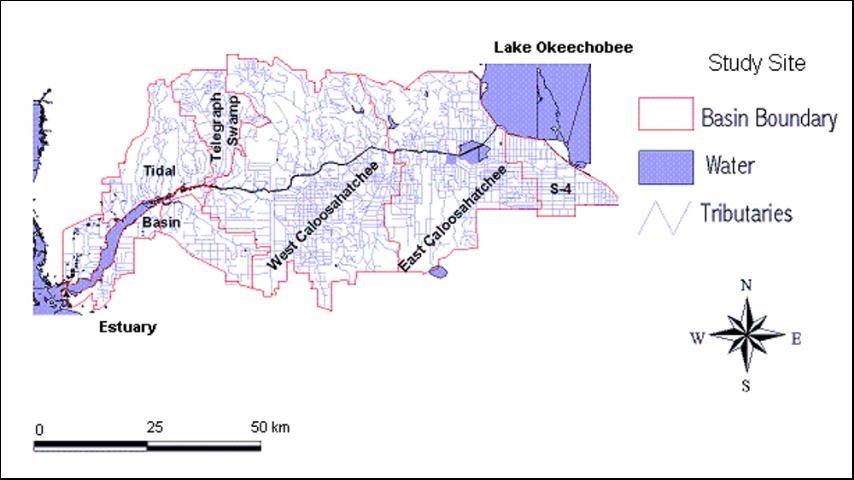
The impoundment was surrounded by a borrow ditch. The name "borrow" is derived from the fact that the material from excavation of this ditch was borrowed to create the impoundment dikes (Figure 2). The borrow ditch collects the grove drainage. To meet the SFWMD stormwater detention/retention regulation, water from the inflow borrow ditch is pumped into the impoundment. A "throw-out pump," a term used to describe drainage pumps, is located in the ditch to pump water from the ditch into the impoundment (Figure 2). With continued pumping into the impoundment, the water in the impoundment exceeds the outflow weir elevation and discharges into an outflow ditch that conveys water outside the grove and eventually to the Caloosahatchee River (Figure 2). An emergency water outlet structure (weir) was also installed at the east side of the impoundment to release water in case the water level rises high enough to endanger the stability of the embankment.
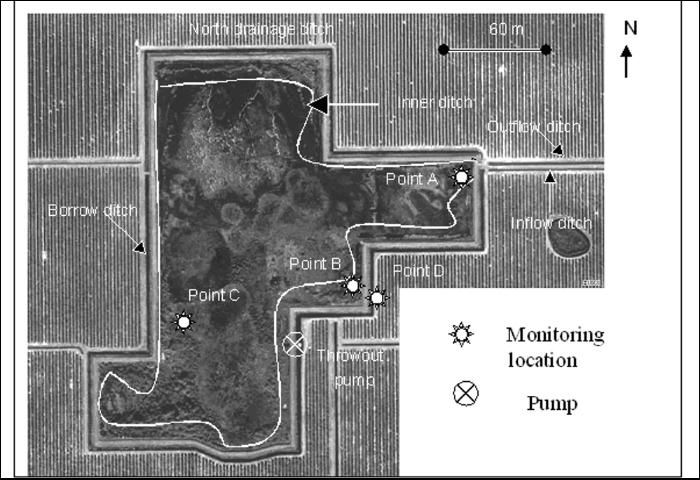
The total grove area was 656.1 ac including the impoundment area of 108.6 ac. The mean ground elevations in the cultivated field area and impoundment were 30.74 ft and 28.84 ft, respectively. The outflow weir elevation was 29.53 ft. The estimated total capacity of the impoundment was 18 million gallons (MG).
To evaluate the feasibility of using the stormwater in the impoundment for water supply, it was assumed that a minimum storage depth of 0.33 ft must be maintained in the deepest half of the impoundment to preserve the ecosystem, reduce the sediment in the usable water, and account for ET losses. Considering the minimum storage, the total maximum available volume for water supply use from the impoundment was 13 MG. To assess the potential for existing or planned impoundments to retain water for reuse by agriculture, three alternatives were evaluated using a hydrologic computer model, MIKE-SHE. The model was tested for its applicability by comparing its results with the observed data. The following alternatives were considered in the model:
Alt. 1: Lining the entire impoundment with a 6-in. thick clay liner;
Alt. 2: Lining the inner ditch inside the impoundment and the embankment; and
Alt. 3: Regular pumping or water recycling.
Present Conditions
An assessment of the present conditions, specifically the volume of water retained in the impoundment without any management/structural changes, was made for comparison with the three alternatives. The assessment of the present conditions was based on the monitoring data and modeling results. The volume in the impoundment fell below the minimum volume for reuse within the first week of the dry season. The two rainfalls that occurred during this period (0.9 in on 11-20-2000 and 1.4 in on 12-28-2000) failed to produce any usable water in the impoundment. The main reason for low available storage appeared to be the high seepage rate from inside the impoundment to the water table or the surrounding ditch.
Alternative 1: Lining the Entire Impoundment
Bentonite is a clay commonly used to line landfills. A 6-in-thick compacted bentonite clay liner in the impoundment bottom and along the embankments was modeled for its ability to reduce seepage losses from the impoundment. Use of the 6-in liner provided increased volume retention when compared with the present condition. The sustained water retention after the November 20, 2000, rainfall event (Figure 3) allowed 3 weeks' worth of irrigation water to be stored. In total, there was enough water available to irrigate the entire grove for a total of 13 weeks during the October 23–May 28 period. For most of the dry period in 2001, southern Florida experienced extreme to exceptional drought. Considering this condition, availability of alternative irrigation water sources is beneficial for citrus production as well as the regional groundwater system. The available water during the January-February period could also be used for freeze protection.
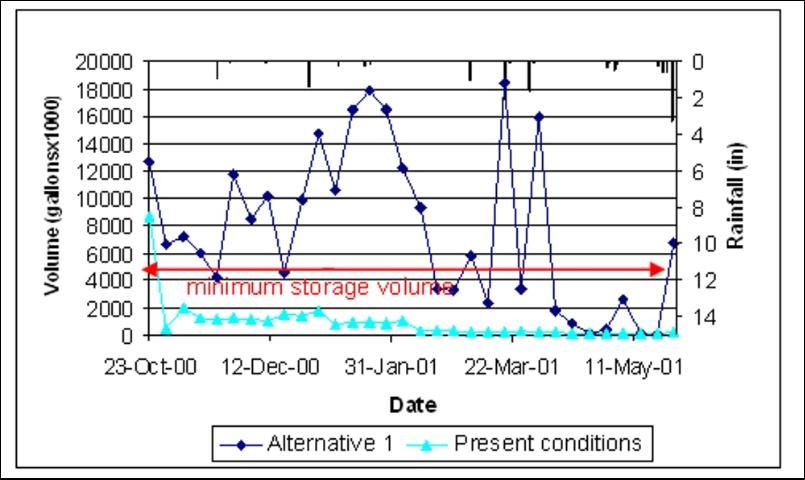
Alternative 2: Lining the Inner Ditch Inside the Impoundment and the Embankment
The purpose of Alternative 2 was to explore if reducing seepage losses through the embankment and from the conveyance canal inside the impoundment will result in improved storage capacity. This alternative is also useful when the impoundment is a protected wetland, but the embankments can be modified. Clay liners with thicknesses of 6 and 12 inches were tested for this alternative. Results for the 6-in-thick liner (Figure 4) show that the quantity and duration of water retention increased compared with the present condition, but were less than Alternative 1. The volume retained after early January 2001 never exceeded the minimum storage volume level in quantities that would provide irrigation water. It would have provided a total of 3 weeks of irrigation water from October 23, 2000, to May 28, 2001. This alternative shows that impoundments designated as protected wetlands might be modified to support ecological functions and serve as alternative water supply sources. These results show that significant seepage losses occur through the embankment and the conveyance ditch inside the impoundment.
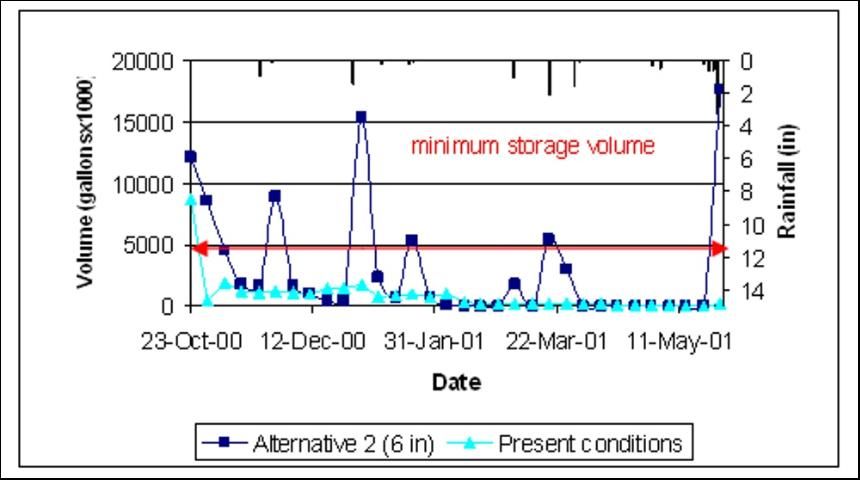
For the 12-in-thick clay liner, evaluation results (Figure 5) showed a higher volume and retention time than with the 6-in clay liner. The choice between these two options (6- and 12-inch-liners) will require a cost-benefit analysis and consideration of effects on the wetland hydroperiod if the impoundment is a protected area. A total of 4 weeks of irrigation could have been provided with a 12-in lining of the embankment. An additional week of irrigation (compared with 6 in) after a rainfall during the dry period, e.g. December (Figure 5), could help sustain a citrus crop under water shortage conditions.
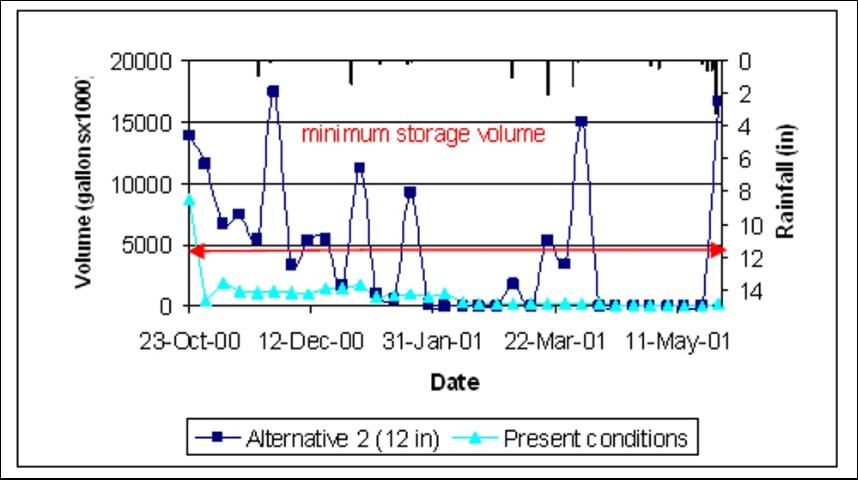
Alternative 3: Regular Pumping or Water Recycling
Alternative 3 is solely a management option and not a structural one. Results of the previous two alternatives showed that the lateral seepage losses were highest through the embankment and the distribution ditch. Whenever the impoundment is full, water seeps out of it and is captured in the surrounding borrow ditch. If water is regularly pumped back inside the impoundment from the borrow ditch, it may result in increased water retention within the grove. Continuous recycling may drastically reduce the water lost to groundwater, part of which may flow outside the grove and eventually to the river. To avoid drying of the ditch, water was pumped into the impoundment for 12 hr once every 3 days at the rate of 8,700 gallons per minute (GPM). This flow was lower than the average amount pumped during the wet season. The pumping period was extended for 1 month (until November 14, 2000). During the entire pumping time, the water volume inside the impoundment was maintained at full capacity (Figure 6). This scenario would provide enough irrigation water for the entire period of pumping up to November 14, 2000. Once the pumping was stopped, the volume receded at rates similar to the present conditions. Results for this alternative are encouraging and call for further investigation with regard to its cost and its effects on the water table in the surrounding groves.
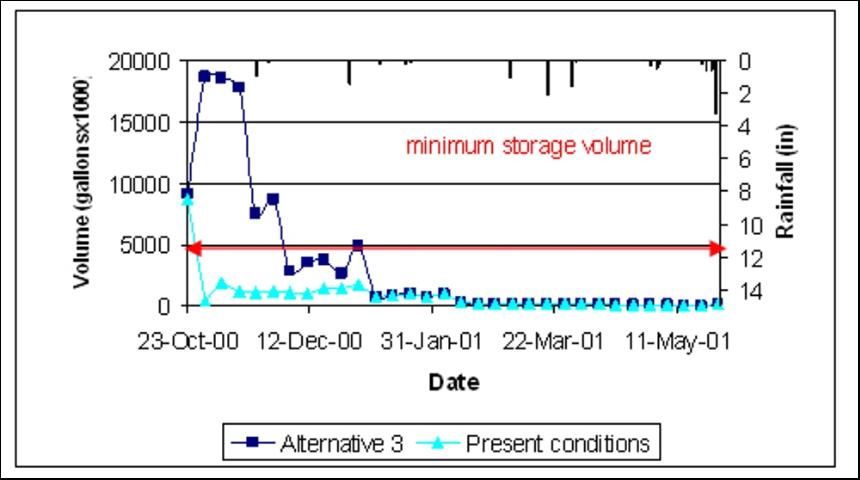
Stormwater Use and Watershed Management
Using stormwater captured in the impoundment as an alternative source of water supply can be beneficial for water conservation and quality. Several options can be explored for using the water from the impoundments, ranging from on-farm irrigation to urban water use.
If the recycled water can be used within the farm to irrigate crops, it will reduce reliance on groundwater. Reduced groundwater withdrawals can help meet the projected increases in south Florida's future water demand. In case of extreme drought, if growers use all available water from impoundments to irrigate crops, they could be given water credits they can use to sustain their crops. Given the high land prices due to urban development and relatively lower profit margins from agriculture, a system could be developed that would allow growers to trade this water with the urban sector (e.g., utility companies). If such a system can be cost effective, it would not only provide an alternative source of water supply but also help increase the profitability of farms and keep the land in agriculture. Maintaining agricultural land has the potential to provide economic benefit and environmental services such as groundwater recharge, reduced runoff, increased hydration of wetlands, and wildlife habitat.
If several impoundments within a watershed can be hydraulically linked to each other to convey the water close to a utility company, a regional reservoir, or an Aquifer Storage and Recovery System (ASR), the harvested water could be made available to water companies or the state for use in urban areas. Stormwater impoundments distributed throughout a watershed such as the Caloosahatchee can act as a distributed reservoir system. Since the land has already been devoted to an impoundment, the cost of harvesting the water may be less than building a large reservoir that will require purchasing large tracts of land.
The alternative uses of water harvested from impoundments discussed above would require a cost-benefit analysis. Given the cost associated with the installation of a water conveyance system to pump the water from the impoundment for irrigation or some other use, the grower would have to be compensated for the cost incurred in installation and maintenance of the infrastructure. If a cost-benefit analysis reveals that trading of stormwater from agricultural areas is economically feasible, it could help sustain the water resources within watersheds in south Florida and provide an additional income source for the agricultural sector.
The use of agricultural impoundments as water supply sources has the potential to partly ameliorate the water shortage in south Florida. Since these impoundments are already built, their use as a water supply will reduce the additional land area required for building new distributed reservoirs. Such use of impoundments may also result in improved downstream water quality due to increased retention of nutrients through plant uptake and increased nutrient assimilation in the impoundments.
Future efforts should be directed at evaluating the combined effects of several impoundments distributed within a large watershed such as the Caloosahatchee River Basin to provide greater insight into the basin-wide effect (e.g., effect on peak river flow and estuarine ecosystems) of harvesting water from impoundments.
References
Boman, B., C. Wilson, M. Jennings, and S. Shukla. 2002. Detention/Retention for Citrus Stormwater Management. AE216. Gainesville: University of Florida Institute of Food and Agricultural Sciences. https://edis.ifas.ufl.edu/AE216 (June 2016)
Fernald E. A. and E. D. Purdum (Eds). 1998. Water Resources Atlas of Florida. Tallahassee, FL.: Institute of Science and Public Affairs, Florida State University.
Flaig, E. 2002. Evaluation of Reservoirs for Water Storage in the Caloosahatchee Watershed: Data Report. Immokalee, FL.: SWFREC, IFAS, University of Florida.
Jaber, F. and S. Shukla. 2004. Simulating water dynamics in stormwater impoundments for water supply. Transactions of the ASAE 47 (5):1465–1476.
MIKE-SHE Water Movement User Manual, Edition 1.2. 1999. DHI, Horsholm, Denmark, 16–20.
National Drought Mitigation Center. Drought Monitor. http://www.drought.unl.edu/ (June 2016)
Shukla, S. and F. H. Jaber. 2003. Evaluation of Reservoirs for Water Storage in the Caloosahatchee Watershed. Final modeling report WRP-003. South Florida Water Management District, Fort Myers Service Center, Fort Myers, FL.
South Florida Water Management District (SFWMD). 1987. Management and Storage of Surface Waters. Resource Control Department.
South Florida Water Management District (SFWMD). 2000a. Lower West Coast Water Supply Plan-Planning Document, Volume 1. West Palm Beach, FL.: Water Supply Planning and Development Department.
South Florida Water Management District (SFWMD). 2000b. Caloosahatchee Water Management Plan. West Palm Beach, FL.
USACOE. 1998. Central and Southern Florida Project Comprehensive Study. Final Integrated Feasibility Report and Programmatic Environmental Impact Statement. Jacksonville, FL.: United States Army Corps of Engineers.
Xevi, E., Christianens, K., Espino, A., Swenandan, W., Mallants, D., S rensen, H., and Feyen, J. 1997. Calibration, validation, and sensitivity analysis of the MIKE-SHE model using the Neuenkirchen catchment as case study. Water Resources Management, 11, 219–242.